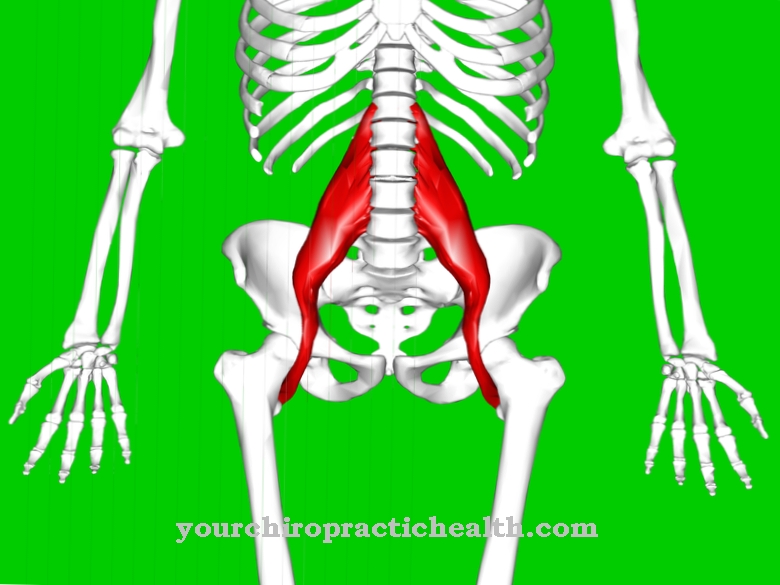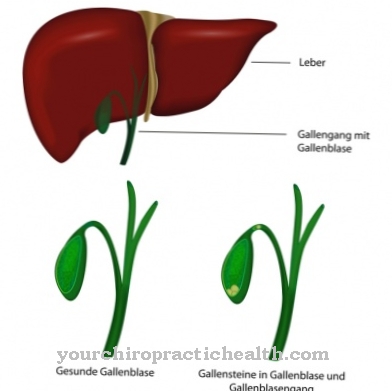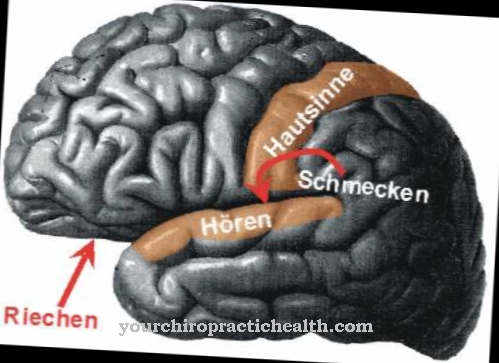Of the Thyroid cartilage belongs to the cartilage skeleton of the larynx. The structure of this cartilage has an impact on voice formation. Thyroid cartilage disorders therefore affect the voice.
What is the thyroid cartilage?
The thyroid cartilage with the Latin term Cartilago thyroidea represents the largest cartilage of the larynx. In English it is called the thyroid cartilage. Outwardly, the thyroid cartilage is visible as an Adam's apple.
The Adam's apple appears particularly prominent in men and is the prerequisite for a deep voice. The Adam's apple is one of the secondary male sexual characteristics. It is formed by a thickening of the thyroid cartilage under the influence of testosterone. Above the thyroid cartilage is the larynx cover (epiglottis), which prevents the passage of food into the windpipe. The epiglottis is connected to the thyroid cartilage.
Below the cartilago thyroidea sits the horizontal cricoid cartilage, which is articulated to the anterior cartilage. The vocal cords or vocal cords stretch out behind the thyroid cartilage. They are connected to one another by adjusting cartilage. The cartilage is held together by various ligaments, with the larynx being suspended from the hyoid bone by means of a membrane.
Anatomy & structure
The thyroid cartilage is made up of two cartilage plates made of hyaline cartilage. These cartilage plates are connected in the front center. Towards the top, there is a small notch in the cartilago thyroidea, which is referred to as the superior thyroid incision.
From the outside it can even be felt. At the bottom there is a smaller inconspicuous notch called Incisura thyroidea inferior. Behind the thyroid cartilage, the vocal cords are stretched between the adjusting cartilages. The cartilago thyroidea forms the anterior side of the larynx. It is still arched a little forward. During puberty, this bulge thickens in young men. The typical Adam's apple forms, with the voice becoming deeper. Four muscles connect to the thyroid cartilage.
The sternothyroid muscle is a skeletal muscle that pulls the thyroid cartilage down. It starts at the linea obliqua, a sloping line structure of the thyroid cartilage. The thyrohyoid muscle is also located on the oblique line and is an extension of the sternothyroideus muscle. By shortening the distance between the hyoid bone and thyroid cartilage, it closes the larynx. Another pharyngeal muscle, the inferior constrictor pharyngis muscle, is located furthest down towards the esophagus. Part of the musculature, the pars thyropharyngea, in turn begins at the linea obliqua.
The other part, the pars cricopharyngea, arises from the lateral edge of the cricoid cartilage. The inferior constrictor pharyngis muscle has two functions. On the one hand, when swallowing, it pushes the pulp towards the esophagus and, on the other hand, it participates in the voice modulations. The cricothyroid muscle is the fourth muscle that is connected to the thyroid cartilage. It begins on the cricoid cartilage and extends to the anterior border of the cartilago thyroidea. He is responsible for the regulation of the tension of the vocal cords and thereby increases the voice frequency.
Function & tasks
The thyroid cartilage largely determines the structure of the larynx and thus has a major influence on its function. Due to its close connection to the larynx muscles and the vocal cords, it is partly responsible for the closure of the larynx when swallowing and for voice formation.
Due to this close connection, structural changes in the thyroid cartilage, such as the formation of the Adam's apple, also lead to a deeper voice. As already mentioned, the individual muscles of the larynx have different tasks. In addition to its function as an important structural component of the larynx, the thyroid cartilage also ensures the fine-tuning of the various processes of voice formation. Even the smooth separation of the functions of the esophagus and trachea is due, among other things, to the work of the thyroid cartilage.
Diseases
Isolated diseases of the thyroid cartilage are very rare. Usually the cartilago thyroidea is affected in inflammation of the larynx (laryngitis), but not the cartilage, but only the mucous membrane is affected.
Laryngitis is often caused by viral infections. A bacterial infection is less common. However, inflammation due to autoimmune diseases is also possible. During these processes the mucous membranes are mainly attacked. When the disease spreads to the vocal cords, hoarseness or even voice loss occurs. There are also various benign and malignant larynx tumors. Benign tumors are more common than malignant ones. Here, too, the thyroid cartilage is usually not affected in isolation. A very common symptom is increasing hoarseness.
More than 90 percent of the malignant forms are squamous cell carcinomas. In turn, the cells of the mucous membrane degenerate. In rare cases, however, chondrosarcoma can also occur. Chondrosarcoma leads to the degeneration of connective tissue cells in the cartilage. Here too, localization in the thyroid cartilage is very rare. Chemotherapy and radiation therapy are unsuccessful in this tumor because the degenerated cartilage cells do not respond to them. The only chance of recovery arises from the complete removal of the tumor.
This may mean having to completely remove the larynx, resulting in loss of voice. If there is swelling under the thyroid cartilage, it may also be a thyroid disorder in which a goiter develops. According to the symptoms, a disease of the thyroid cartilage is superficially suspected. However, a neighboring organ is affected.

























.jpg)

.jpg)
